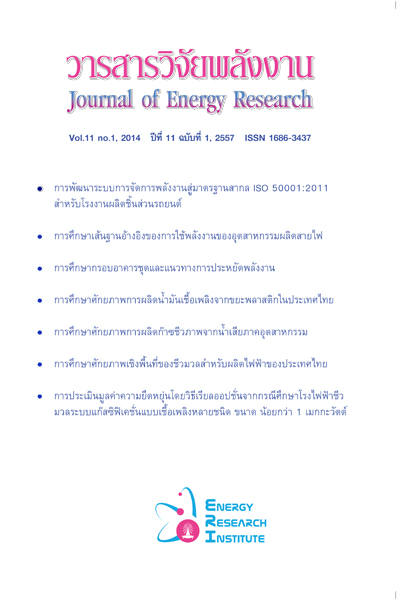การศึกษาศักยภาพเชิงพื้นที่ของชีวมวลสำหรับผลิตไฟฟ้าของประเทศไทย
Main Article Content
Abstract
การวิจัยนี้มีจุดประสงค์เพื่อศึกษาศักยภาพเชิงพื้นที่ของชีวมวลสำหรับผลิตไฟฟ้าภายในประเทศ ณ ปัจจุบัน และนำไปเปรียบเทียบกับกำลังผลิตไฟฟ้าในปี พ.ศ. 2573 ตามแผนพัฒนากำลังผลิตไฟฟ้าของประเทศไทย พ.ศ. 2553-2573
ชีวมวลที่นำมาศึกษา คือชีวมวลจากพืชเศรษฐกิจ 5 ชนิดของไทย ได้แก่ ข้าว อ้อย ข้าวโพด มันสำปะหลัง และปาล์มน้ำมัน ซึ่งแบ่งเป็นสองประเภท คือประเภทกระจุกตัว และประเภทกระจายตัว ปัจจัยที่นำมาวิเคราะห์ ได้แก่ พื้นที่เพาะปลูก ระยะห่างของสายส่งไฟฟ้า และโรงไฟฟ้าชีวมวลขนาดเล็กและเล็กมาก โดยใช้โปรแกรมสารสนเทศภูมิศาสตร์ในการทำแผนที่ จากการศึกษาพบว่าพื้นที่ส่วนใหญ่ของประเทศมีศักยภาพในการนำชีวมวลมาใช้ผลิตไฟฟ้า โดยศักยภาพเชิงพื้นที่ของ
ชีวมวลประเภทกระจุกตัวมี 1,865 เมกะวัตต์ และประเภทกระจายตัวมี 6,882 เมกะวัตต์ ดังนั้นหากเปรียบเทียบกับ
กำลังผลิตไฟฟ้าจากชีวมวล 3,260 เมกะวัตต์ ตามแผนพัฒนากำลังผลิตไฟฟ้าในปี พ.ศ. 2573 จะพบว่าชีวมวลประเภทกระจุกตัวเพียงอย่างเดียวไม่สามารถตอบสนองกำลังการผลิตไฟฟ้าตามแผนดังกล่าวได้ จำเป็นต้องใช้ชีวมวลประเภทกระจายตัวร่วมด้วย ซึ่งศักยภาพรวมของชีวมวลทั้งสองประเภทคิดเป็น 2.7 เท่าของกำลังผลิตไฟฟ้าตามแผนดังกล่าว นอกจากนี้การศึกษานี้ยังพบว่าชีวมวลประเภทกระจุกตัวที่มีศักยภาพในการผลิตไฟฟ้าสูงที่สุดคือ แกลบ 714 เมกะวัตต์ ส่วนประเภทกระจายตัว คือฟางข้าว 1,788 เมกะวัตต์ ซึ่งชีวมวลทั้งสองประเภทส่วนใหญ่กระจายตัวอยู่ในภาคเหนือและภาคอีสาน
A Study on Spatial Potential of Biomass for Electricity Generation
The purpose of this study is to estimate the current spatial potential of biomass to produce electricity in Thailand and to compare with the planned electricity capacity generated from biomass in 2030 which is the end of Power Development Plan 2010 Revision 3. Biomass in this study is Thailand’s 5 economic crops; i.e. rice, sugarcane, corn, potato, and palm; which can be categorized by its source into concentrated (i.e. industrialized) type and spread type. The factors to be analyzed are cultivated area and the distance from power line to small and very small biomass power plants, using geographic information system program. The study found that most area in Thailand has potential of biomass for electricity generation, in which spatial potential of concentrated biomass and spread biomass are 1,865 MW and 6,882 MW respectively. Therefore, compared to electricity capacity 3,260 MW generated from biomass plan in 2030, it can be concluded that concentrated biomass alone cannot respond to electricity capacity in such plan. Spread biomass is needed and total potential of both biomass will be 2.7 times of planned electricity capacity. Besides, this study also found that the concentrated biomass which has the most potential to generate electricity is rice husk (714 MW) while the spread biomass is rice straw (1,788 MW) that exist mostly in North and Northeast area.

